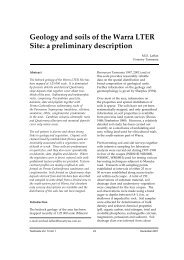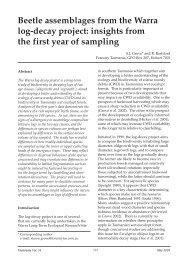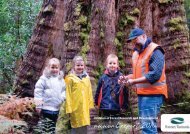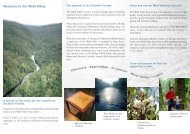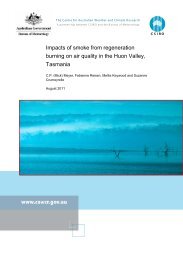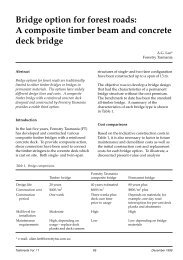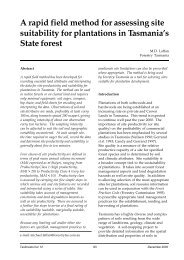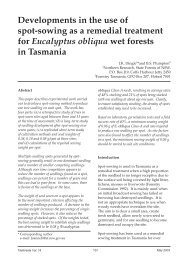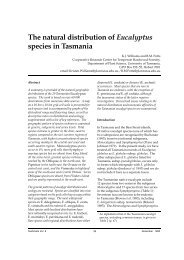sustainable forest management - Forestry Tasmania
sustainable forest management - Forestry Tasmania
sustainable forest management - Forestry Tasmania
Create successful ePaper yourself
Turn your PDF publications into a flip-book with our unique Google optimized e-Paper software.
egulatory environmenT<br />
Continuous improvement<br />
<strong>Forestry</strong> <strong>Tasmania</strong>’s objective is to comply with all relevant<br />
legislation and supplementary standards. Research<br />
is important to identify opportunities for continuous<br />
improvement in <strong>forest</strong> <strong>management</strong>. <strong>Forestry</strong> <strong>Tasmania</strong><br />
maintains a practical research program to improve the<br />
productivity and sustainability of the <strong>management</strong> of<br />
state <strong>forest</strong>s. The research facilitates the development and<br />
sharing of expertise with <strong>forest</strong> managers, collaborative<br />
partners and the broader public. More detailed trend data<br />
for this section can be found in Appendix one.<br />
Forest Practices Act 1985<br />
All <strong>forest</strong> practices must be carried out in accordance with a<br />
certified Forest Practices Plan which contains specifications<br />
for harvesting, roadworks and re<strong>forest</strong>ation activities in<br />
accordance with the Forest Practices Code. The code<br />
requires special provision to protect natural and cultural<br />
values, including flora, fauna, geomorphology, soils and<br />
water, cultural heritage and visual amenity.<br />
The emphasis of the <strong>forest</strong> practices system is to achieve<br />
high environmental standards through planning, training<br />
and education. Where problems arise corrective action,<br />
including the remediation of damage, takes place. This is<br />
followed by review, analysis and improvement of systems to<br />
ensure that similar errors do not occur in the future. Where<br />
the problem is considered serious, legal enforcement can<br />
be applied in a number of ways. This includes verbal or<br />
written notification by a Forest Practices Officer issued<br />
under Section 41 of the Forest Practices Act. The Forest<br />
Practices Authority (FPA) can also prosecute for failure to<br />
comply with a certified Forest Practices Plan or may impose<br />
a fine as an alternative to prosecution.<br />
During 2007/08 no S41 notices were issued to <strong>Forestry</strong><br />
<strong>Tasmania</strong>, however, seven were issued to <strong>Forestry</strong> <strong>Tasmania</strong><br />
contractors as a result of the following non-compliances:<br />
•<br />
•<br />
•<br />
•<br />
•<br />
•<br />
•<br />
A harvesting operation continued after rain where the<br />
certified Forest Practices Plan called for the road to be<br />
used only in dry conditions.<br />
Blocked culverts were found on a spur road while<br />
another spur road did not meet specifications in the<br />
certified Forest Practices Plan or the Forest Practices<br />
Code.<br />
Puddling of soils was found to have occurred in one<br />
harvesting operation.<br />
No cording was carried out on a main snig track during<br />
wet periods.<br />
The construction of a landing commenced without the<br />
required approval being finalised.<br />
A landing was found to be inadequately corded.<br />
A contractor harvested outside of the designated<br />
harvesting boundary.<br />
Cording involves the use of suitable logs, bark or<br />
vegetation to spread the weight of the load and<br />
seperate machine tyres or tracks from direct soil<br />
contact during harvesting operations, thus reducing<br />
ground pressure and rutting.<br />
<strong>Forestry</strong> <strong>Tasmania</strong> was fined $25,000 in the 2007/08<br />
financial year following a Forest Practices Authority<br />
investigation that was undertaken into a breach reported<br />
in June 2006. The breach was discovered by <strong>Forestry</strong><br />
<strong>Tasmania</strong> when an aerial photograph showed a discrepancy<br />
between the actual shape of the harvested area and the<br />
intended shape as set out in the Forest Practices Plan.<br />
Investigations showed that 4.24 hectares of the adjacent<br />
921 hectare Arve Loop Forest Reserve was inadvertently<br />
harvested, along with a strip of land designated by <strong>Forestry</strong><br />
<strong>Tasmania</strong> as a corridor for wildlife. Equipment failure and<br />
human error contributed to the breach. Seven hectares<br />
of <strong>forest</strong>s containing similar conservation values as the<br />
area harvested were reserved in addition to the harvested<br />
area in the <strong>forest</strong> reserve and the wildlife corridor is being<br />
rehabilitated back to native <strong>forest</strong>.<br />
The Forest Practices Authority undertakes an independent<br />
annual audit of a representative sample of all Forest Practice<br />
Plans. The audit covers <strong>forest</strong> harvesting, roadworks and<br />
site preparation at various stages of completion. In addition<br />
to the assessment of operational performance, the audit<br />
checks the standard of the plan, including all assessments<br />
and procedures required by the <strong>forest</strong> practices system.<br />
The overall outcome of the 2007/08 Forest Practices<br />
Authority audit was an average statewide rating of 3.8<br />
which is better than the “Above Sound” benchmark (3.5) set<br />
by <strong>Forestry</strong> <strong>Tasmania</strong>.<br />
49




